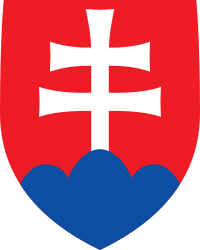Coat of Arms of Slovakia
| Coat of arms of Slovakia | |
|---|---|
 |
|
| Details | |
| Armiger | Slovak Republic |
| Adopted | 1 January 1993 (13 June 1919) |
| Escutcheon | Gules, a mount of three peaks Azure, issuant therefrom a double cross Argent |
The coat of arms of Slovakia consists of a red (gules) shield, in early Gothic style, charged with a silver (argent) double cross standing on the middle peak of a dark blue mountain consisting of three peaks. Extremities of the cross are amplified, and its ends are concaved. The double cross is a symbol of its Christian faith and the hills represent three symbolic mountain ranges: Tatra, Fatra (made up of the Veľká Fatra and Malá Fatra ranges), and Mátra (the last one is in northern Hungary).
One of the modern interpretations of the double cross is that it represents Slovakia as an heir and guardian of Christian tradition, brought to the region by St. Cyril and St. Methodius, two missionaries from the Byzantine Empire.
The two-barred cross in the Slovak coat of arms originated in the Byzantine (Eastern Roman) Empire in the 9th century. Unlike the Christian cross, the symbolism and meaning of the double cross is not well understood. One interpretation is that the first horizontal line symbolized the secular power and the other horizontal line the ecclesiastic power of Byzantine emperors. Another that the first cross represents the death and the second cross the resurrection of Jesus Christ. In the Byzantine Empire of the 9th century, the double cross was a political symbol used by Byzantine clerks and missionaries.
The double cross arrived in the territory of current-day Slovakia probably no later than during the 9th century mission of Cyril and Methodius to Great Moravia. Though used frequently in Great Moravia, it was not a state symbol at that time, because there were no state symbols in the modern sense in Europe at that time yet. By means of Zwentibold (the ruler of Lorraine, son of the German emperor Arnulf of Carinthia and godchild of the Great Moravian king Svatopluk I), this symbol got to Lorraine and is called the cross of Lorraine there.
...
Wikipedia
